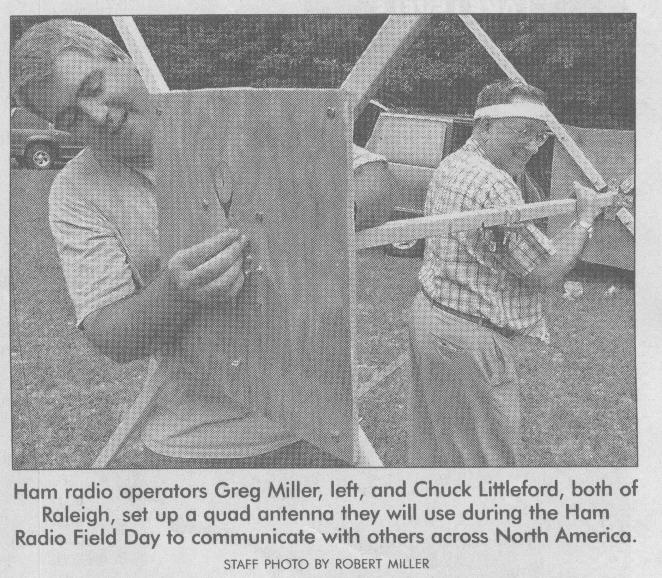 |
Triangle radio operators to ham it up at Field Day |
|
Users to hone skills in 24-hour event By CHRIS JENKINS, Staff Writer
"I'm just intrigued with all kinds of technology," said Wittich, 43, who often talks with other users on his drive home from the office. "It's a great hobby for those who love to figure out how things work." This weekend, Wittich will have an opportunity to show off his expertise with many other Triangle amateur radio users, or hams. They will participate in Field Day, a 24-hour exercise in which hams practice communicating with other enthusiasts across North America. The drill is meant to help sharpen skills in case of emergencies such as hurricanes, tornadoes and earthquakes. "Most people think of ham-radio users as people sitting
in the middle of a field talking to people in exotic places," Wittich said. Field Day also is a contest in which hams compete to see which operator can communicate with the most users across the continent. In years past, the more advanced hams have contacted up to 1,000 people in one day, according to members of the Raleigh Amateur Radio Society. Awards are given out in November for the person who makes the most contacts. "I usually just come out so that I can hone my abilities," said Robert Keys, 52, an associate professor of Crop Science at N.C. State University. "It's important to put the commitment into practice." Keys added that he communicated by ham radio for 25 years with his father in Los Angeles, and that it was still an important way of keeping up with his family across the country. Ham radio is a hobby dating back to the early part of the century. The radios can send messages by voice or International Morse Code to users all over the world. Although radios can be as cheap as $100, some people can spend up to $1,000 on equipment, said Gary Pearce, a member of the Raleigh society. In Wake County, Field Day participants began gathering in a large field just south of Apex at 2 p.m. Friday. In Durham, Field Day operations will be at Eno River State Park, starting this morning. The contest's rules allow 24 hours to set up before today's exercise. Wittich said contestants often attach wire antennas to arrows, coiling them around the branches of tall trees so they can get the most powerful effect. Beyond casual conversation and natural disasters, there are other ham radio uses that enthusiasts say many people do not know about. Amateur radio is often used during bicycle races or walkathons so that organizers can keep up with an events' progress over long distances. This week, the radios were used in a Triangle solar car race so that drivers could communicate with one another, and organizers could monitor participants' progress. "People find it much more useful than cell phones in events like that ... because you can talk to a number of people at one time," said Pearce, 49, a Raleigh producer, who has been a ham user since 1965. But even as the hobby enjoys a significant following, with about 650,000 users nationally, interest has dwindled slightly over the past several years. "We used to have an exclusive on easy worldwide
communication where you didn't have to deal with the telephone company,"
Pearce said. "But now, with the Internet, we've lost that edge."
Chris Jenkins can be reached
Ed. note: The text, photograph and graphic in this article
is from the 6/26/99 Raleigh News and Observer and is copyrighted
(c)
1999 News and Observer. The original article may be accessed
on the web -click
here. Photograph is from the printed edition of the Raleigh
News and Observer.at 829-8937 or chrisj@nando.com |
|
 "But in times of disaster, it usually is the only form of communication.
This is what we are going to be practicing this weekend." Wittich added
that many ham users help the National Weather Service give up-to-the-minute
reports on weather because the radios are mobile and can reach several
sources at one time.
"But in times of disaster, it usually is the only form of communication.
This is what we are going to be practicing this weekend." Wittich added
that many ham users help the National Weather Service give up-to-the-minute
reports on weather because the radios are mobile and can reach several
sources at one time.